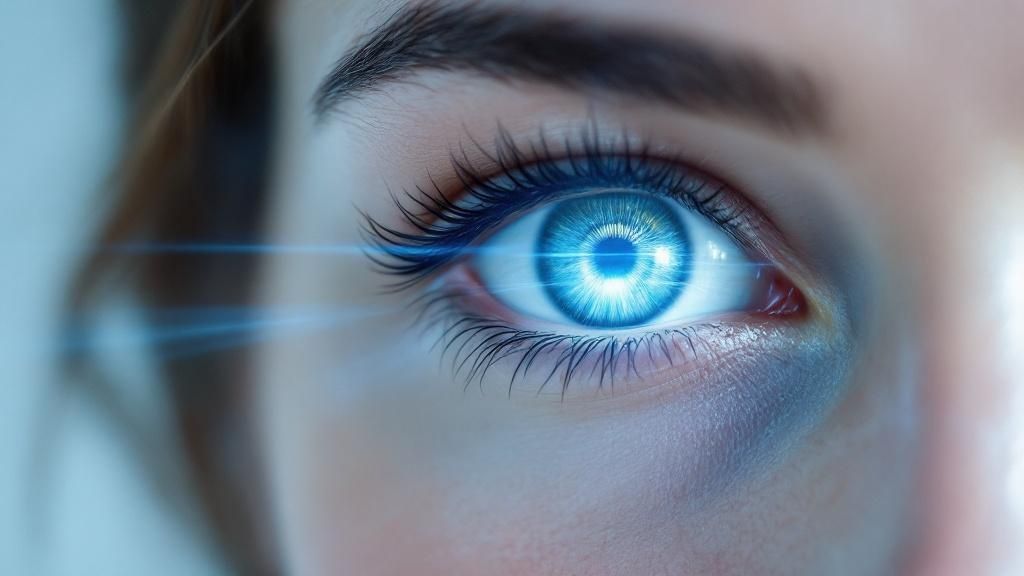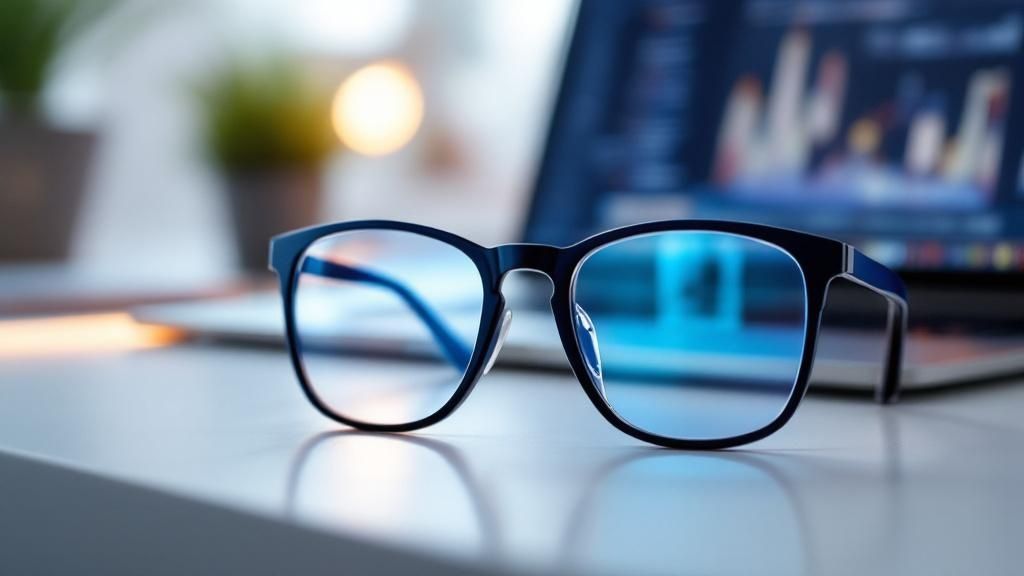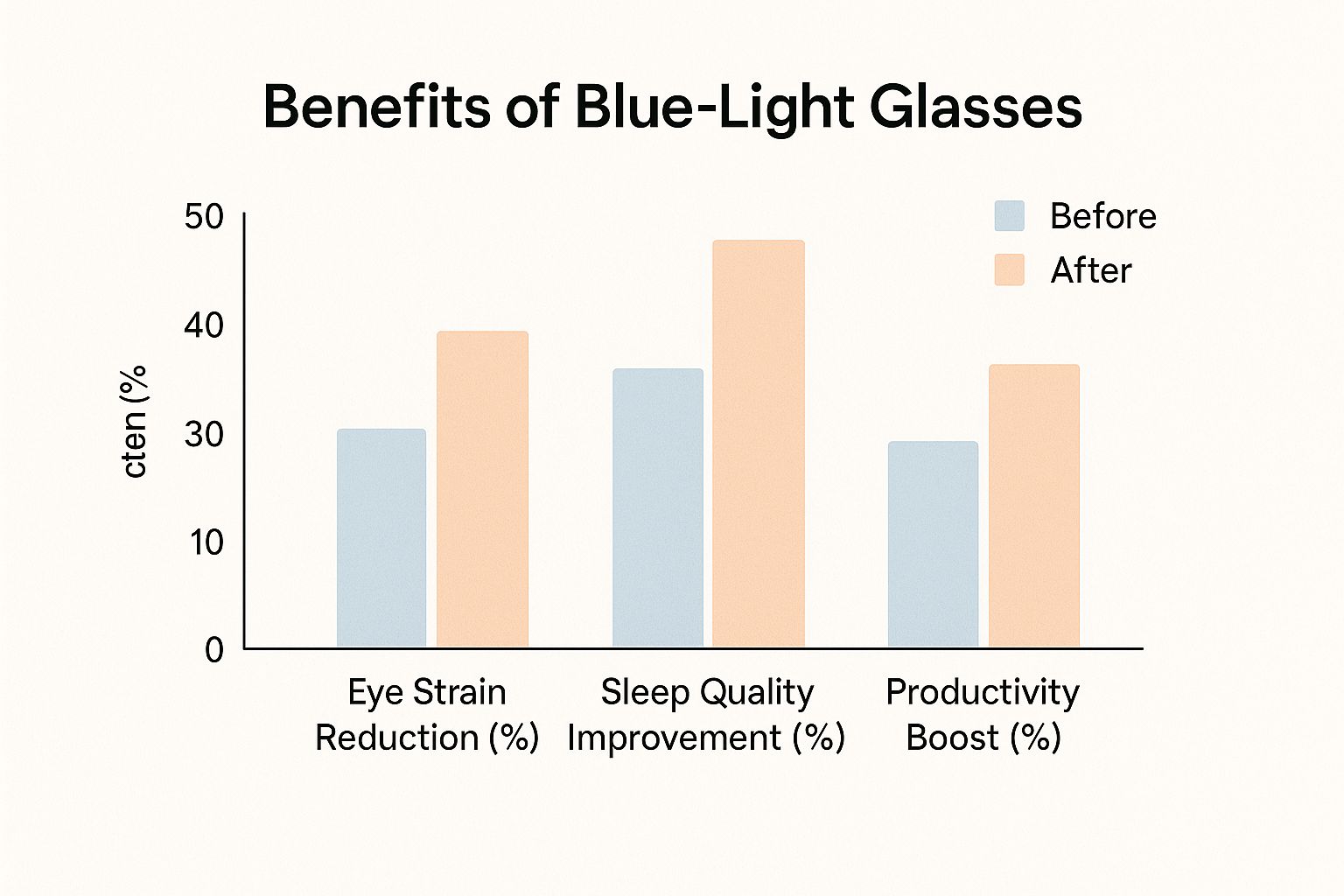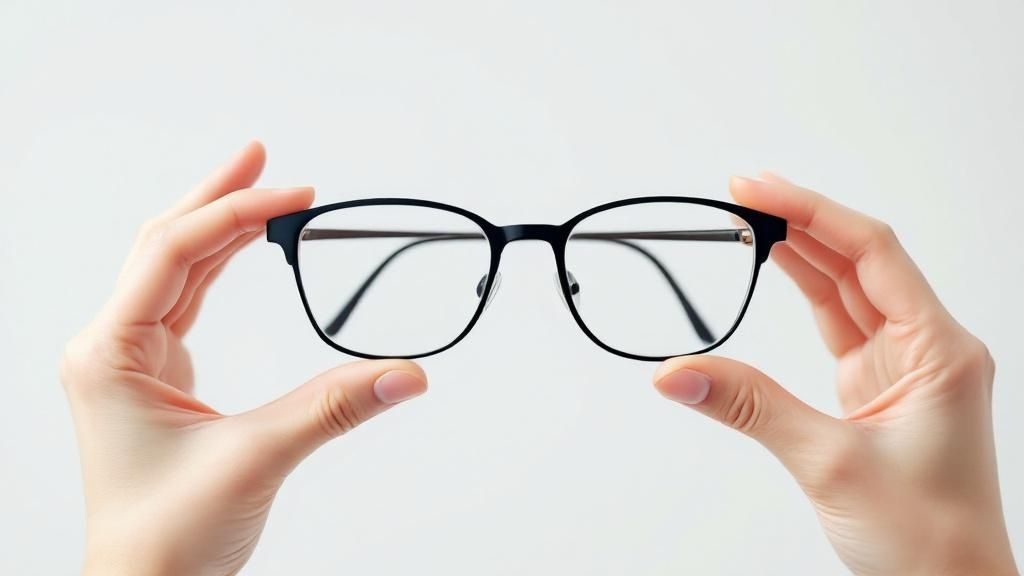
A Practical Guide to Glasses for Screen Time
That gritty, tired-eye feeling you get after hours staring at a computer? That's digital eye strain, and it's become a near-universal complaint. Glasses for screen time are built specifically to tackle this problem head-on by filtering out the harsh blue light beaming from our devices. Think of them as a protective shield, giving your hard-working eyes a much-needed break.
Why Screens Make Your Eyes Feel So Exhausted
If you’ve ever wrapped up a long day at the computer with a dull headache or fuzzy vision, you're definitely not alone. Staring at a screen locks your eyes into a state of constant, focused effort. It’s a lot like trying to hold a tough yoga pose for hours—eventually, the muscles just give out from the sustained tension.
Our eyes simply weren't designed to stare at glowing pixels for eight hours a day. Unlike the crisp, solid edges of text on a printed page, the letters and images on a screen are made up of tiny points of light. Your eyes have to constantly readjust and struggle to maintain focus on these pixelated images, forcing the tiny muscles inside them to work overtime.
The Role of High-Energy Blue Light
On top of that muscle fatigue, our devices blast our eyes with intense, high-energy visible (HEV) blue light. This specific part of the light spectrum is known to scatter more easily than other colors, which creates a kind of visual "noise" or static. This effect reduces contrast on the screen, making it even more difficult for your eyes to focus clearly.
It's a bit like trying to follow a conversation in a crowded, noisy room. All that background chatter forces you to strain to pick out the words. Blue light does something similar to your vision, creating a visual static that makes your eyes work that much harder just to see what’s right in front of you.
This one-two punch of intense focus and disruptive light is a direct cause of some very common symptoms:
- Dry, irritated eyes because we blink far less often when we're focused on a screen.
- Nagging headaches and neck pain that often stem from the strain on your eye muscles.
- Mental and physical fatigue as your brain burns extra energy trying to process all that messy visual information.
Over time, it all adds up, tanking your comfort and your productivity. Slipping on a pair of glasses for screen time is a simple but incredibly effective way to push back against this daily digital barrage and give your eyes the relief they deserve.
How Blue Light Filtering Actually Protects Your Eyes

To really get how glasses for screen time work, think of the light blasting from your device like a full orchestra. Most of the sound is fine, but the blue light is that one trumpet section playing way too loud, making everything else feel harsh and jarring.
Blue light filtering lenses are like a sound engineer for your eyes. They don't just mute the whole orchestra. Instead, they skillfully turn down the volume on those overpowering trumpets, letting the rest of the music—all the other colors of light—come through much more clearly and comfortably. The result is a far more pleasant visual experience.
The Two Main Filtering Technologies
This isn't some kind of magic trick; it's just smart optical science. Glasses for screen time mainly use two different methods to tame that high-energy light. Each one takes a slightly different path to the same destination: visual comfort.
1. Blue Light Absorption
First up is absorption. Many of these lenses are crafted from a special polymer that has blue-light-filtering particles mixed right into the material. These particles are like tiny sponges, soaking up a specific amount of the blue light wavelengths before they ever get a chance to hit your retina. It's an incredibly effective method that often gives the lenses a very faint, warm, or yellowish tint—a subtle sign that they're hard at work capturing that harsh light.
2. Blue Light Reflection
The other common approach involves applying a highly specialized coating to the lens surface. This coating is engineered to be a mirror, but only for certain blue light wavelengths. When that intense blue light hits the lens, a portion of it is simply bounced away, keeping it from passing through to your eye. Lenses using this tech often look almost perfectly clear but might show a slight blue or purple reflective sheen if you catch them in the right light.
Both of these technologies are great at reducing your exposure to high-energy blue light, and you'll find that many of the best glasses for screen time actually blend both methods to give you the most comprehensive protection.
Why Filtering Matters for Comfort
By zeroing in on and reducing the most disruptive wavelengths, these glasses do a few key things to protect your eyes. They cut down on the visual "noise" that leads to digital eye strain, which in turn helps reduce the headaches and fatigue that come from staring at screens all day.
This targeted filtering also directly tackles the scattering effect of blue light—the very thing that can make text and images on your screen look a little fuzzy. By managing this light, the lenses actually improve contrast and clarity, letting your eye muscles finally relax instead of constantly straining to focus.
The science on this is pretty clear, showing a solid link between managing artificial light and improving how our eyes feel. If you want to dive into the data yourself, you can explore a ton of great information from blue light studies and information detailing the effects on our eyes and sleep cycles. At the end of the day, this technology gives us a practical, science-backed way to handle a very modern problem, making our screen-filled lives a whole lot more comfortable.
The Real-World Benefits of Using Screen Glasses

Understanding the science is one thing, but what really matters is how these glasses actually improve your day-to-day life. The benefits aren't just theoretical ideas—they're real, tangible improvements you can often feel from the very first day you put them on.
Think about it like swapping your standard office chair for a high-end ergonomic one. You’re still getting the work done, but the difference in your comfort and how long you can last is huge. That's exactly what screen glasses are: an ergonomic tool for your eyes. They can turn a strained, uncomfortable experience into one that’s sustainable and much more pleasant.
Reduce Digital Eye Strain and Headaches
The first thing most people notice is a serious drop in digital eye strain. You know that gritty, dry, tired feeling that creeps in after a few hours in front of a monitor? That starts to fade away. By filtering out the harshest parts of the light spectrum, these glasses cut down on the visual "noise" that makes your eye muscles work overtime.
This has a direct knock-on effect on other issues. Those nagging tension headaches that start behind your eyes and spread across your forehead tend to become less frequent and less intense. Your vision can even feel clearer and sharper, without the frustrating blurriness that often sets in after staring at a screen for too long.
This need for visual relief is exactly why protective eyewear is becoming so popular. The market is growing because more and more office workers, students, and gamers are feeling the effects of screen-related strain. These glasses directly combat the negative side effects of blue light, like eye fatigue and sleep problems. As digital device use climbs worldwide, so does consumer health awareness, fueling the demand. You can learn more about the growing anti-blue light glasses market and see the trend for yourself.
Promote Better Sleep Cycles
One of the most powerful benefits of screen time glasses actually kicks in long after you've logged off. When you're exposed to artificial blue light in the evening, it basically tricks your brain into thinking it's still daytime. This suppresses the production of melatonin, the crucial hormone that tells your body it’s time to wind down and sleep.
By wearing blue light filtering glasses for just a couple of hours before bed, you put up a protective shield. This simple act allows your brain’s natural rhythm to take over and produce melatonin on schedule.
Wearing screen glasses in the evening is like drawing blackout curtains in your bedroom. It signals to your brain that the day is ending, allowing your natural sleep cycle to begin on schedule, uninhibited by artificial light.
This small change in your routine can lead to some pretty significant improvements in your sleep quality, including:
- Falling asleep faster: Without the stimulating effects of blue light keeping you wired, you’ll find it much easier to relax and drift off.
- Deeper, more restorative sleep: When your melatonin production is on track, you get higher-quality rest.
- Waking up feeling more refreshed: Nothing beats starting the day with a full battery, and proper sleep is how you get there.
Enhance Focus and Productivity
When your eyes aren't constantly fighting discomfort, your brain has more resources to focus on what you're actually trying to do. By cutting down on eye strain and headaches, you're removing a major source of distraction that pulls you out of your flow.
This translates directly to better productivity. It doesn't matter if you're coding, writing, designing, or gaming—when your eyes are comfortable, you can stay in the zone for longer. You can work or play without that physical and mental fatigue forcing you to take a break, making your screen time far more efficient and enjoyable.
How to Choose the Right Pair of Screen Glasses
Picking out the perfect pair of glasses for screen time might feel like a big deal, but it really doesn't have to be. If you focus on just a few key things, you can easily find eyewear that fits your life, makes you more comfortable, and even matches your style.
First things first: think about when you'll be wearing them. Are you trying to get some relief during those long days at the office? Or do you need serious protection for late-night gaming sessions or scrolling? Your answer points directly to the most important decision: the type of lens you need.
Consider the Lens Tint and Filtering Strength
Not all blue-light-filtering lenses are made the same. The most obvious difference is the tint of the lens, which is a dead giveaway for how much blue light it's actually blocking.
-
Nearly Clear Lenses: These are your go-to for daytime and office use. They typically filter a lower amount of blue light (30-40%) but are engineered to cut down on eye strain without messing up your color perception. This makes them perfect for designers, video editors, and anyone whose job relies on seeing colors accurately.
-
Amber or Yellow Tinted Lenses: Stepping up the protection, these lenses block a more significant 50-70% of blue light. The relief is much more noticeable, making them a great fit for people who are extra sensitive to screen glare or who spend long, unbroken hours staring at a monitor.
-
Red or Dark Amber Lenses: Think of these as your evening champions. You'll want to pop these on a few hours before bed. By blocking over 90% of blue light, they give your brain the maximum defense it needs to produce melatonin naturally, which is key for a healthy sleep cycle.
This chart shows the kind of real-world results people often report after making blue light glasses a regular part of their routine.

As you can see, the improvements in eye strain, sleep quality, and even productivity are pretty significant. It's a clear link between the technology and tangible, everyday benefits.
To help you decide, here's a quick comparison of which features matter most for different activities.
Feature Comparison for Screen Time Glasses
This table helps you decide which features are most important based on your primary use case, whether it's for general office work, late-night use, or intensive gaming.
| Feature | Best for Office Work / Daytime Use | Best for Gaming / Intense Focus | Best for Evening / Pre-Sleep Use |
|---|---|---|---|
| Blue Light Filtering % | Low (30-40%) | Medium (50-70%) | High (90%+) |
| Lens Tint | Clear or very light yellow | Yellow or light amber | Dark amber or red |
| Color Accuracy | Highest priority | Important, but comfort is key | Not a priority |
| Frame Material | Lightweight (acetate, titanium) | Durable & lightweight | Any comfortable material |
| Fit & Comfort | All-day comfort is essential | Secure fit that stays in place | Relaxed, comfortable fit |
Ultimately, your daily routine will be the best guide for choosing the right lens and frame combination.
Prioritize Frame Fit and Overall Comfort
Even the most powerful lenses are useless if the glasses are too uncomfortable to wear. You're going to have these on for hours, so comfort is absolutely non-negotiable.
Look for frames made from materials that are both lightweight and tough, like acetate, titanium, or flexible polymers. Pay close attention to how they fit—they shouldn't pinch your nose, slide down constantly, or squeeze your temples. The right fit means you'll eventually forget you're even wearing them, which is exactly what you want.
Think of your screen glasses like a good pair of running shoes. You wouldn't run a marathon in shoes that pinch or slide. Similarly, for the marathon of a workday, you need frames that provide steady, comfortable support from morning to night.
Prescription vs. Non-Prescription Options
Deciding between prescription (Rx) and non-prescription (plano) lenses is pretty simple. If you already wear glasses to see, you'll want to get the blue light filter added directly to your prescription lenses. Almost every optometrist and online glasses shop offers this as a standard feature now.
If you don't need vision correction, then non-prescription plano lenses are what you're after. You get all the protective perks of the blue light filter without any optical power you don't need. If you're still on the fence, our guide on what blue light glasses are and if you should wear them can help clear things up.
The demand for these glasses is growing fast, and for good reason—the benefits for office workers, students, and gamers are becoming undeniable. The global market for blue light blocking glasses is expected to reach nearly USD 5.99 billion by 2035. Making a smart choice today puts you ahead of the curve in taking care of your eyes.
Healthy Screen Habits to Complement Your Glasses

While glasses for screen time are a fantastic first line of defense against digital eye strain, they really shine when you pair them with a more mindful approach to your digital life. Think of them as one piece of a complete wellness puzzle for your eyes.
By building a few simple, healthy habits, you can create a powerful, layered strategy to protect your vision for the long haul. These aren't massive lifestyle changes, but they deliver significant rewards in comfort and eye health, working hand-in-hand with your glasses to tackle the root causes of strain.
Follow the 20-20-20 Rule
One of the best habits you can possibly adopt is the 20-20-20 rule. It’s incredibly simple but gives your eye muscles a desperately needed break from the constant, fixed focus that screens demand.
For every 20 minutes you spend staring at a screen, take a 20-second break to look at something at least 20 feet away.
This tiny action lets the ciliary muscles inside your eyes finally relax, preventing the fatigue that builds up from hours of close-up work. Set a timer or use a browser extension to nudge you until it becomes automatic. It's truly one of the most effective ways to actively reduce eye strain from your computer.
Optimize Your Workspace and Device Settings
Your physical environment plays a surprisingly huge role in how your eyes feel at the end of the day. A few small tweaks to your setup can make a world of difference.
- Position Your Screen: Make sure your monitor is about an arm's length away. The top of the screen should be at or just below eye level. This simple adjustment prevents you from craning your neck or straining your eyes upward.
- Control the Lighting: Try to avoid placing your screen where you’ll get glare from a window or harsh overhead lights. Softer, ambient room lighting is your friend—it reduces the stark contrast between your bright screen and a dark room.
Don't forget to use the tools already built into your devices! Activating "Night Shift" on Apple products or "Night Light" on Windows and Android will automatically warm up your screen's color temperature as the evening rolls in. This cuts down on blue light right at the source, adding another crucial layer of protection.
And since heavy screen time can mess with your rest, it's also smart to look at practices that improve your sleep quality. You might even want to explore some sleep-boosting apps designed to help you unwind and get a more restorative night's sleep.
Common Questions About Screen Time Glasses
Even with all the benefits laid out, it's natural to have a few lingering questions. When you're thinking about investing in your eye health, you want to be completely sure you’re making the right move. Let's dig into some of the most common questions people ask about glasses for screen time and clear up any confusion.
Think of this as your go-to guide for quick, straightforward answers, so you can feel totally confident in your decision.
Do These Glasses Actually Work?
This is the big one, and the short answer is yes. But it’s crucial to understand how they work. While the scientific community is still digging into all the long-term effects of blue light, the immediate comfort users feel is undeniable. The main job of these glasses is to cut down on the visual "noise" that comes from high-energy light.
By filtering a slice of this intense light, the glasses help ease digital eye strain—which is a very real thing. That reduction in strain is what leads to fewer headaches, less tired eyes, and just a more comfortable experience during long hours in front of a screen.
Is It Okay to Wear Them All Day?
For most people, wearing screen time glasses all day is perfectly fine. If you have a pair with nearly clear lenses designed for daytime, they only filter a small, specific amount of blue light. It's just enough to soften the harsh glare from your screen without messing with your vision or how you see colors, making them perfect for the office.
You wouldn't wear dark sunglasses inside, right? The same logic applies here. Use glasses with a light filter for daytime work and keep the stronger, amber-tinted lenses for the evening. That's the best way to protect your natural sleep cycle.
What's the Real Difference Between Cheap and Expensive Pairs?
The price tag usually boils down to a few key things: the quality of the lens, how durable the coatings are, and the frame construction. Cheaper pairs might offer some basic blue light filtering, but the premium glasses often use more advanced lens technology that gives you sharper vision with much less color distortion.
On top of that, higher-quality glasses usually come with tougher anti-scratch and anti-reflective coatings. The frames are also built for a better, more comfortable fit and are made to last, using materials like lightweight titanium or premium acetate. You’re really paying for better optics, durability, and all-day comfort.
Do I Need a Prescription?
That depends entirely on what your eyes need right now. If you don't wear glasses for vision correction, a standard pair of non-prescription (or "plano") lenses with a blue light filter is all you need.
But if you already wear glasses to see clearly, you should absolutely get your prescription with an added blue light filtering coat. Demand for this has exploded—the global market for prescription blue light blocking glasses was pegged to be worth $2.5 billion in 2025 and is still growing fast. You can dive deeper into the prescription blue light glasses market growth to see the trend. Combining your vision correction with screen protection is easily the smartest and most convenient choice.
Ready to give your eyes the relief they deserve? Explore the full collection of stylish and effective blue light blocking glasses at Spektrum Glasses and find your perfect pair today. Visit https://www.spektrumglasses.com to see the difference.
